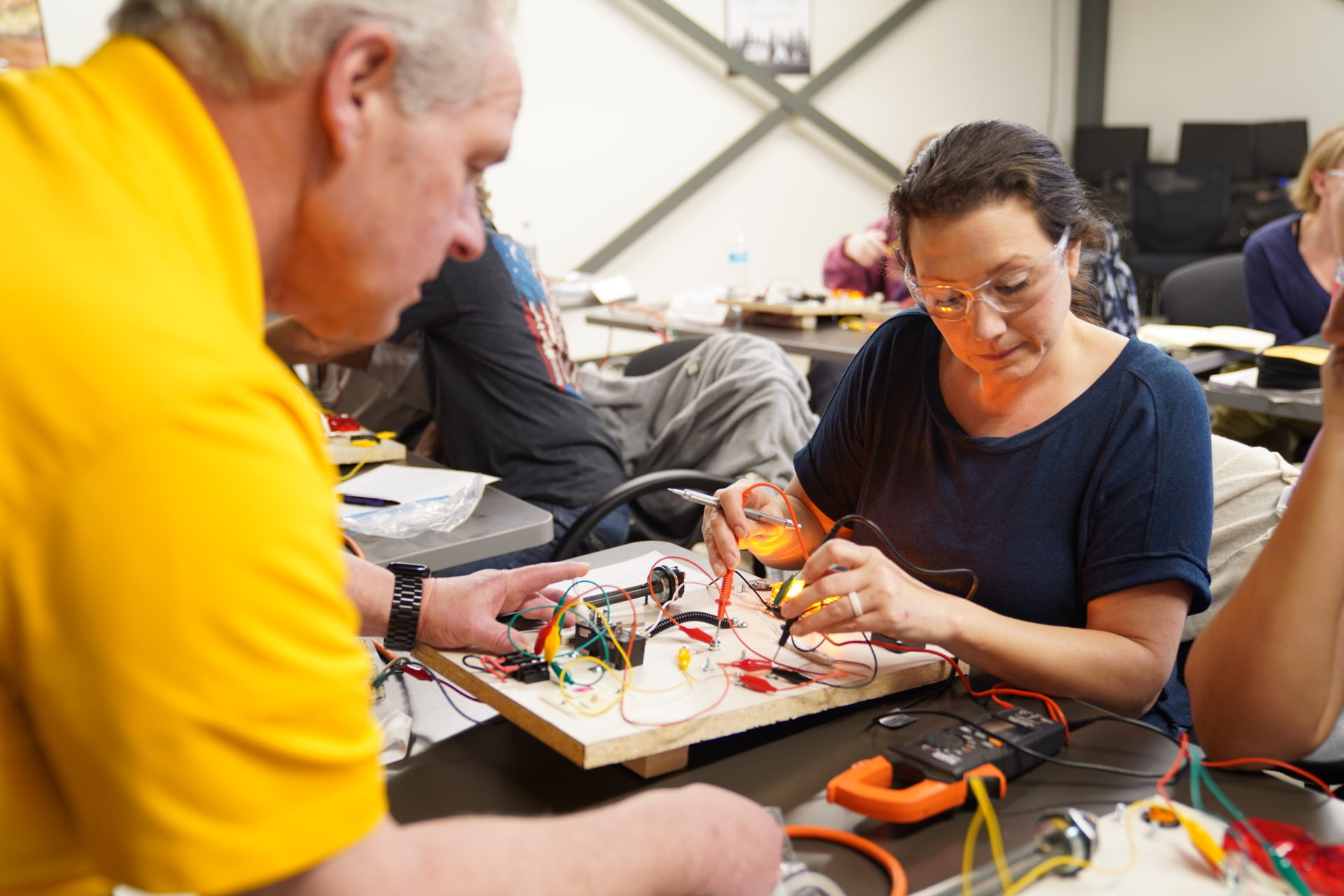
How to handle critique without losing your creative spark
Posted by
You’ve poured your heart and soul into your creation. Your painting, story, song, or design is a piece of you. So when someone offers a critique, it can feel like a direct hit to your confidence, right? It’s easy to let that feedback, even if it’s meant to be helpful, dim your creative light.
Constructive criticism isn’t supposed to be an attack on you as a person, or an attack at all! A critique is feedback on the art you created. Effective, valuable critiques analyze your artistic choices, techniques, and the impact of your work. After all, art is subjective, and different opinions contribute to making it rich and entertaining.
Throughout your career, many people will offer feedback, including peers, teachers, professors, professionals, and mentors. The value of their constructive criticism? To help you level up by identifying areas of improvement and fresh perspectives you may not have considered, making your art even stronger.
Preparing for a critique
Receiving feedback, even when it’s not your first time, can be a little nerve-wracking. Try this mindset. Look at critiques as learning opportunities. Each piece of feedback offers a chance to grow and improve.
Try detaching yourself emotionally from your creation. Imagining it belongs to someone else can help you listen more objectively without feeling like every comment is a personal attack. Set specific goals for feedback before the critique session so you can guide the discussion and get the most helpful insights.
- Bring a notebook, phone, or recording device (if allowed) to jot down/record the feedback, helping you accurately remember what was said for later review.
- Struggling with a particular area? Prepare your own questions to direct the conversation to where you need the most help. For example, “What do you think about this color palette?” or “Was the ending clear?”
- Often, the most productive way to engage with feedback is by sharing your intentions and asking where they’ve fallen short. Being able to explain your choices can help transform a critique into a deeper discussion.
How to listen and engage
It’s the moment of truth with your art on display. As people offer feedback, it’s tempting to jump in and explain yourself, but take a deep breath first and try this instead:
- Listen more, talk less. It’s probably the hardest to do because your first instinct might be to interrupt or defend your choices. Resist the urge! For now, absorb, letting everyone finish their thoughts.
- Zoom in on the details. Don’t just hear “I don’t like it.” Ask yourself why? Pay attention to the specifics in the critique. Is it the lighting in a particular scene of your film? Your vocal projection in a certain verse? Color choice in a section of your painting? The more specific you get, the more actionable the feedback becomes.
- Spot the patterns. As different people provide feedback, do you notice any recurring themes or points? Three different people mentioning that the ending of your story feels rushed is a pretty strong clue that there’s something to explore there.
Ask smart questions
Actively listening to constructive criticism lets you ask targeted questions, gain insights into your work’s strengths and areas for improvement, and transform vague comments into actionable advice. Follow up and ask for clarification.
- Could you explain what you meant by…?
- What specific part of [the element they mentioned] isn’t working for you?
- Do you have any suggestions for how I might address [the element they mentioned]?
Dodge the defense dragon
The trickiest part of receiving constructive criticism? Avoiding that defensive feeling. Here’s how to manage it.
- When you feel the heat rising, breathe. A quick, deep breath gives you a second or two to process before reacting.
- You don’t have to agree with everything, but do acknowledge it. Responses like, “I understand your point about…” or “That’s an interesting observation” show you’re listening without committing to changing.
- Remember, it’s not personal. If you need to repeat it as a mantra, go for it. This feedback is critiquing your work, not you. Reframe those negative emotions — like frustration or disappointment — as fuel for improvement, and you’ve won half the battle.

Processing and using your feedback
The feedback session ends, and ideas are swirling. The next step is crucial: How do you use that feedback to improve your art without feeling overwhelmed or losing your style or vision?
Reflect (and chill)
Don’t feel pressured to start changing things the second a feedback session ends. Give yourself some space.
Step away. Your brain needs time to digest and process. Trying to implement changes immediately can create frustration or rush decisions you might regret later.
Once you’ve breathed, review your notes. Try organizing the feedback, perhaps by themes or by what felt most impactful. This activity can help you identify patterns and remember specific details, clarifying your next steps.
Filter and prioritize
Not all feedback is created equal; you don’t have to act on every suggestion. Become the editor of your own growth.
Look for actionable feedback. “This part feels off” helps less than “The lighting in this scene makes it hard to see the actor’s expression.” Focus on the comments giving you clear steps.
Consider the source. While all perspectives have value, input from a teacher, professor, trusted mentor, or professional in your field may carry more weight than a comment from a peer still learning how to give useful feedback. Remember that diverse opinions have the power to introduce new possibilities.
Trust your gut. After all, this is your art. If a piece of feedback misaligns with your artistic vision, it’s okay to set it aside. Sometimes, sticking to your instincts is the bravest choice.
Develop a plan of action
Once you reflect and filter, turn that feedback into forward momentum.
- Set specific goals. Instead of thinking “I need to improve,” make your goal concrete. “I’ll experiment with XYZ lighting techniques in my next piece” or “I’ll incorporate more exposition into my character dialogue in the next chapter.”
- Practice and experiment. The best way to use feedback? Apply it! Experiment with it in current or future projects. That’s where the real learning and growth happen.
- Ask for a follow-up (if it feels right). If you have a good relationship with the person (or people) offering constructive feedback, show them your progress after you’ve incorporated their recommendations.
Remember: Constructive criticism isn’t meant to change who you are or what you create. True feedback offers new tools and perspectives to make your art more powerful and impactful.
 Keeping your spark alive
Keeping your spark alive
Some people struggle to keep their excitement and passion when they receive constructive feedback, especially if it skews negative. I’ve been writing for over 30 years, and the number of rejection letters and emails (not to mention the not-so-constructive criticism I’ve received) gets a little overwhelming and wearing.
Years ago, I didn’t always respond with a nod and respond, “I’ll take your suggestions under advisement.” I took every critique personally, even if the person behind it didn’t have my best interests at heart.
The longer I’ve stuck with my art, the thicker my skin has grown. I’ve learned to identify those who don’t want their feedback to help me grow in my art. Now, their criticism slides right off my Teflon skin.
You can do the same.
You’re more than your art
You’re an artist. Your art is part of you, but it’s not all of you. You have many layers and talents beyond what you create. A critique or even a rejection of a single piece or performance doesn’t define your value as an artist or as a person. Your worth is inherent.
Art is a journey. There will always be something new to discover, a skill to master, or a perspective to gain.
See mistakes not as failures but as opportunities for discovery. Some of the coolest breakthroughs in art happened because someone messed up and then ran with it.
Celebrate the little wins. Did you nail that tricky perspective? Compose a melody that finally clicks? Acknowledge every improvement and bit of progress, no matter how small. These victories add up and fuel your motivation.
Remember your why
When you get discouraged, stop, breathe, and remember why you started creating in the first place. What sparked that initial joy? What story did you want to tell? What feeling did you want to evoke?
Use every challenge and piece of difficult feedback to reinforce your dedication — and as a reminder that you love creating and sharing your art.
Blog Categories
- Career Advice
- College Admissions
- Colleges & Universities
- Financial Aid and Scholarships
- For Counselors
- For Parents
- For Students
- Gap Years
- Mental Health and Wellness
- Online Learning
- Performing and Visual Arts
- STEM Majors and More
- Summer Programs
- Teen Volunteering
- Trade & Vocational Schools
- Tutoring & Test Prep

Organization with listings on TeenLife? Login here
Register for Free
We’re here to help you find your best-fit teen-centered academic and enrichment opportunities.
Forgot Password
"*" indicates required fields

 Keeping your spark alive
Keeping your spark alive






